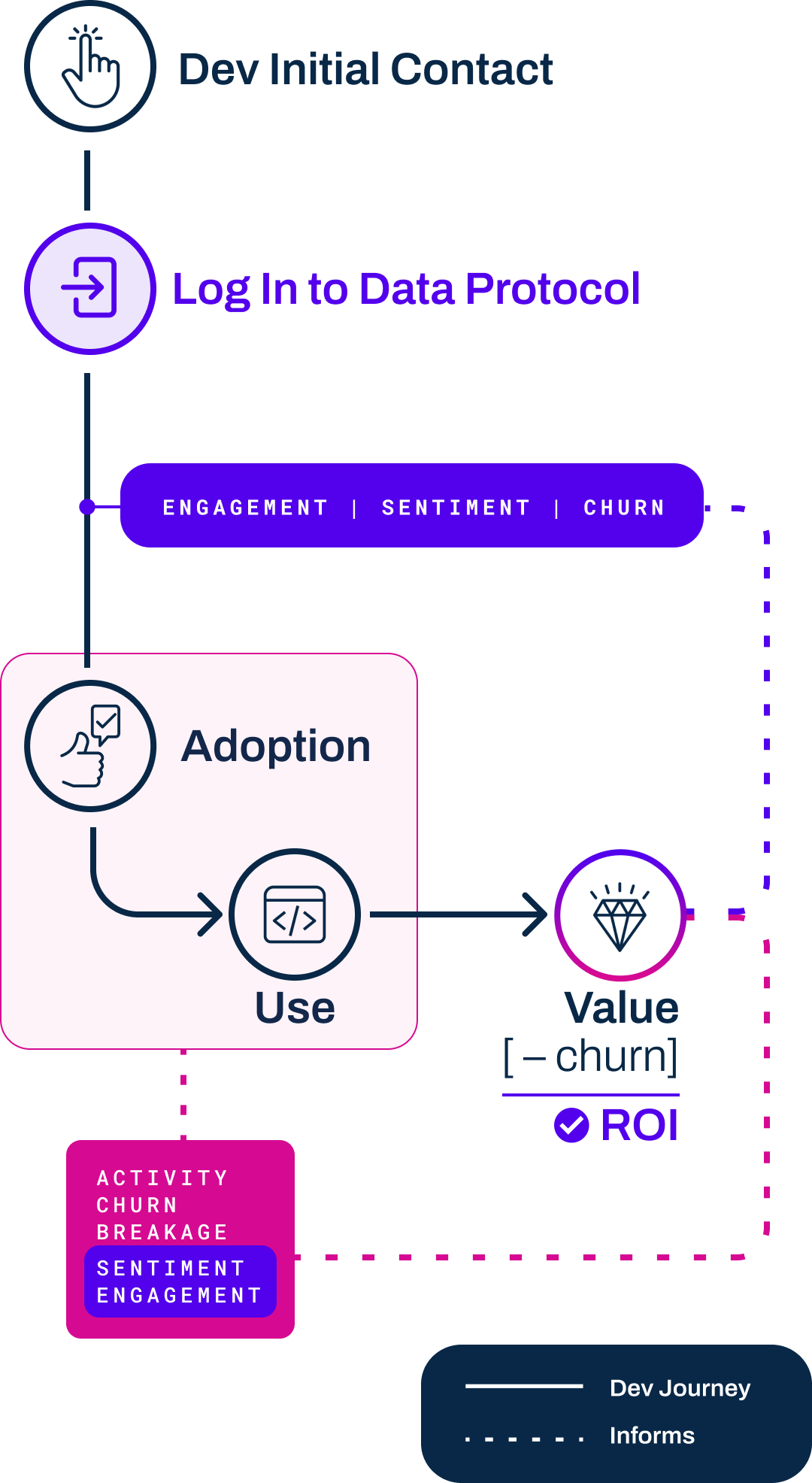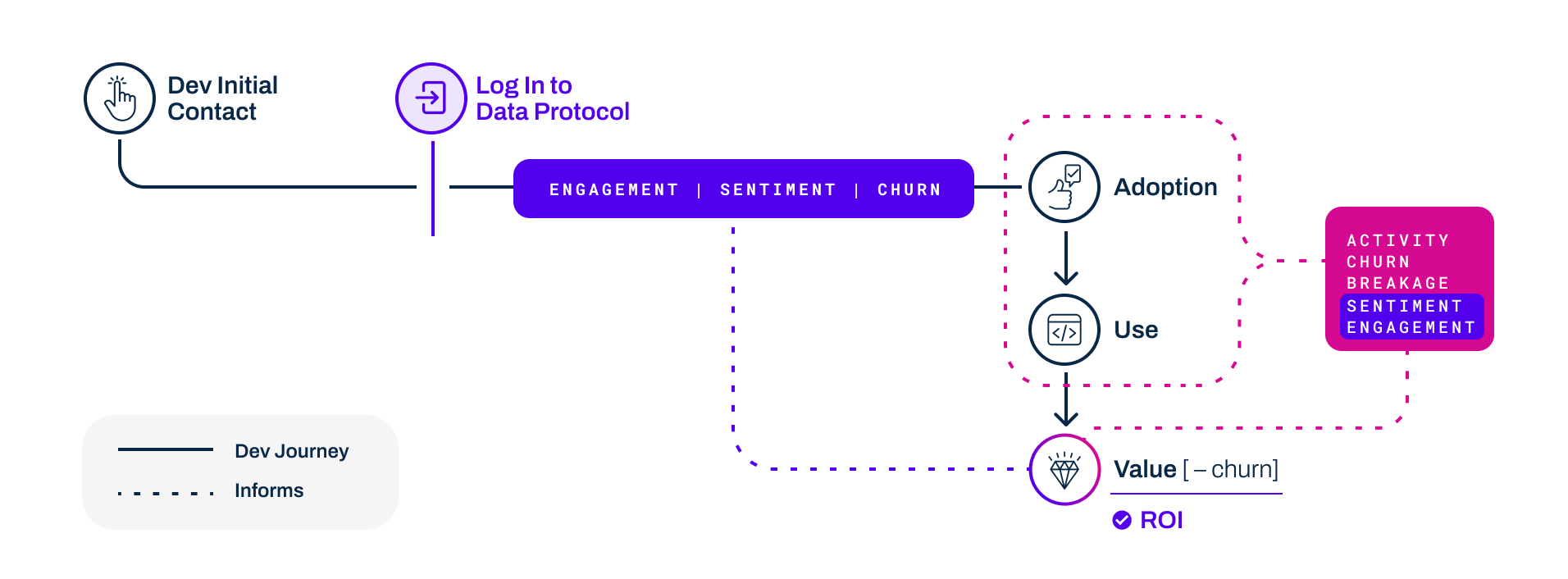IMPROVING DEVELOPER ONBOARDING - a playbook
Reduce Churn, Decrease Breakage, & Increase LTV
Introduction
Developers are your closest partners and you've invested significant resources to attract and convert them. An onboarding process that welcomes new developers from potential partner to valued customer is fundamental to hitting growth targets at the top of the funnel, and delivering value at the bottom. To maximize the lifetime value of each developer (LTV), you need to give them the resources they need - when they need them - and build a mutually beneficial relationship.
The expectations you set early in the onboarding process will pay dividends throughout the lifecycle of your developers. A happy and satisfied developer is much less likely to leave, reducing churn. A well supported and engaged developer is much less likely to break your product (or their own), decreasing the cost of support. A well informed and sustained developer is a more valuable partner. It is worth the investment.
Check-in
Answer the check-in questions throughout the playbook to find out how your onboarding program ranks, and how you could improve.
Optimize your onboarding process by aligning engagement and support with the goals of your developer audience, right from the start. Every developer considering your product wants to know:
- Will this do what I need it to (solve my problem)?
- Will it scale with me (keep solving my problem)?
- How much does it cost (is it worth it)?
- Do I have the support I need (will someone help me)?
These are not just questions to be answered or obstacles to be overcome; they are an opportunity to build understanding, initiate a relationship, and begin to exchange value. Don't ask your potential developers to navigate static developer documentation or search through blogs for use cases. Show them how your product works and how it will work for them. Ask them to sign in using a single-click registration with the promise of a better, faster, and more efficient way to receive support - then give it to them. The attributable feedback and data you're able to gather will finally shed light on this critical part of the developer journey.
Data Protocol Unlocks Value From the Beginning
Integrate Data Protocol into your onboarding process to measure pre-adoption activity and access data you've always wanted and never had.
What is the actual LTV of your developers?

Data Protocol gives developers what they need, the way they want it delivered. We produce and host video content and interactive resources to bring your dev docs to life. Through a branded channel on the Data Protocol platform, we give your potential, new, and existing developers the information they need wherever they are in their lifecycle. And best of all, integrating Data Protocol into your onboarding process unlocks pre and post adoption data you have always wanted, but could never access. This is our playbook.
Step 01: Lead with Video
Dev docs may be the standard, but they are a black box for data and a consistent point of frustration for developers. Don't leave it up to your developers to navigate their way through documentation. Meet your new developers with a handshake rather than a memo.

Video is a more engaging and dynamic way of delivering information. It is preferred by the vast majority of developers, and has been the primary way of learning for the past 15 years. Embrace the freedom of speed and efficiency it gives you and your developers. That said, don't simply record anything just to check the box. Recording a presentation from a funny angle with bad lighting is much worse than a voiced over powerpoint, neither of which are worthy of your effort or your developers' time.

Take this opportunity to capture the passion and expertise of your team. Bring the personal connection of your evangelists, advocates, and support teams directly to your developers. Video is a tool, not a silver bullet, but it is the absolute best way to convey information to your potential and new developers during the onboarding process.
Check-in
1/3
Do you use video in your onboarding process?
Step 02: Provide Context — It Matters
You've spent a lot of time creating and maintaining dev docs to support your developers. This is standard practice and generally accepted, but static web pages are limited. Even a comprehensive library of documentation is only as valuable if it's timely and available. Prioritize delivering information and resources to your developers when they need it, and always with context.
The goal is to build an onboarding process that reflects the nuance of decisions developers need to make both pre and post adoption. For example, a standard getting started developer document can be dramatically improved by adding a layer of interactivity.
Leading developers to specific answers, rather than asking them to ⌘F their way through a document, is more effective at delivering information and answering questions.


This will be much easier if you follow Step 1 and adopt a video first approach to your onboarding and developer support activities. You shouldn't do away with developer documentation and code snippets or even blog posts and emails, rather, add a layer of short, engaging video content through which you can deliver links to those resources and highlight what's important, and when. The context matters.
Check-in
2/3
Select whether each phrase describes your onboarding content:
It's interactive and relies on video to guide developers
Developers can easily find the information they are looking for
Resources are contextualized in one place
We know how developers use our content
Step 03: Ask Questions — Often
Once you're able to deliver information more efficiently and provide potential developers with a better onboarding experience, it's time to ask for their feedback. If you're feeling brave, you may also want to ask their opinion before improving your process. Either way, you've put the building blocks of a more optimized onboarding process in place. You're creating attribution earlier in the funnel, you're leading with video, and you're prioritizing resources as needed. Take advantage of the increased engagement with your developer audience (pre-adoption) and partners (post-adoption), and ask them for feedback.
Ask your developers what they need from you and even what they think about the support you're providing, early and often. Sentiment feedback is more than a simple thumbs up / thumbs down, it opens a line of communication that will continue to add value over the span of the developer lifecycle. Gather that feedback before adoption (and before use) to set a baseline, inform your process, and improve your product.

Developers who have what they need to succeed, early in their journey, stay longer and build better products. Feedback is the best way to find indicators of frustration that lead to costly churn and breakage. The more you know, the better you can support your developers. Everyone wins.
Check-in
3/3
Ask yourself:
Is our onboarding experience easy to navigate?
Do developers have a clear path to success?
Are we certain that developers know how to use our product effectively?
Do we know what is causing developers to churn?
Can we place a value on reducing churn and breakage?
Are we targeting the right people in marketing?
If you answered 'No' - why not?
If you answered 'Yes' - how do you know?
If you're not leading with video content to set expectations and deliver resources more efficiently, you're missing an opportunity to reduce churn and create value. If you're not measuring engagement and sentiment from the first point of contact throughout the developer journey, you are only seeing part of the picture. Developers want to use your product. They want to build and they want to create value. You need to unlock attributable metrics before adoption to capture that value. Don't let an unclear onboarding experience be a barrier in their journey.
The Data Protocol Approach
Data Protocol is a developer engagement and support platform. On behalf of our partners, we produce and host dynamic content and interactive resources for their developers. When integrated into the onboarding process of any developer-first company, Data Protocol deepens engagement, improves conversion, and gathers valuable, attributable metrics.
Your Results:
Answer the check-in questions throughout the playbook to see how your onboarding program is performing, and how you can improve.
Here's how we help you:
Integrate Data Protocol to immediately improve your onboarding process. Give your developers what they need, the way they want and finally have the metrics and data you need to inform and improve your program.
Let's Talk
